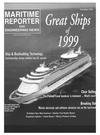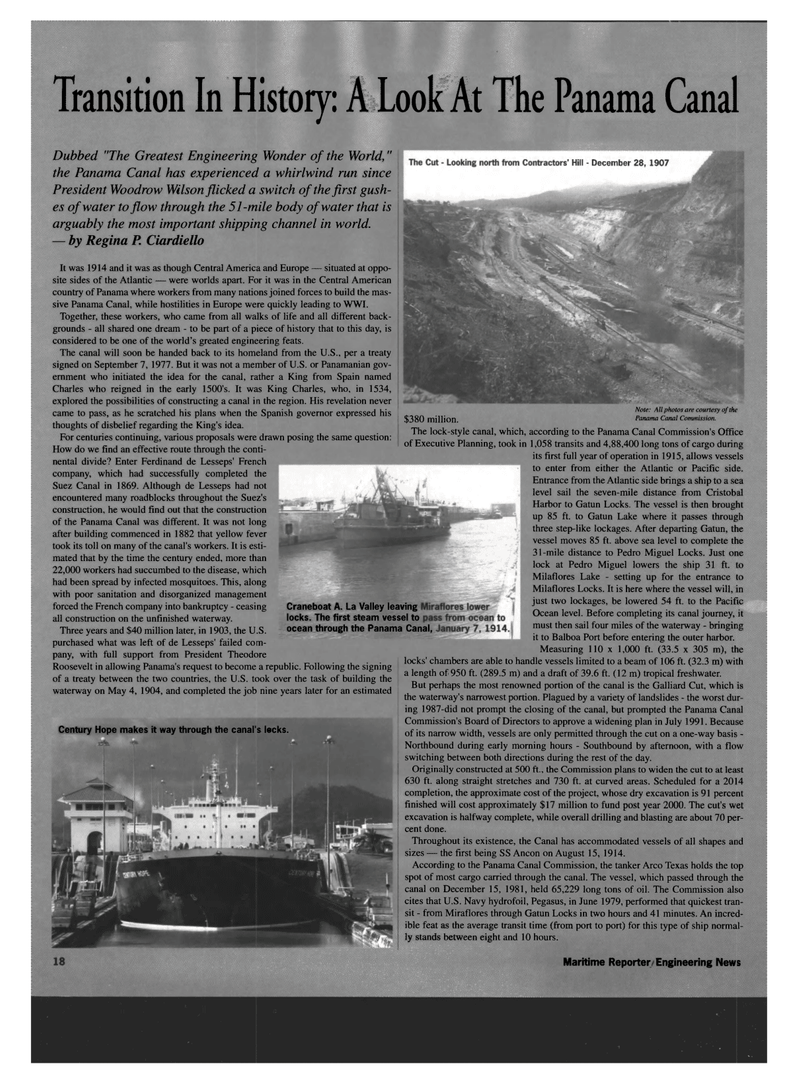
Page 18: of Maritime Reporter Magazine (December 1999)
Read this page in Pdf, Flash or Html5 edition of December 1999 Maritime Reporter Magazine
Transition In History: A Look At The Panama Canal
Dubbed "The Greatest Engineering Wonder of the World," the Panama Canal has experienced a whirlwind run since
President Woodrow Wilson flicked a switch of the first gush- es of water to flow through the 51-mile body of water that is arguably the most important shipping channel in world. — by Regina P. Ciardiello 20 Maritime Reporter & Engineering News
Craneboat A. La Valley leaving locks. The first steam vessel to ocean through the Panama Canal,
Note: All photos are courtesy of the $380 million. Panama Canal Cotruhission.
The lock-style canal, which, according to the Panama Canal Commission's Office of Executive Planning, took in 1,058 transits and 4,88,400 long tons of cargo during its first full year of operation in 1915, allows vessels to enter from either the Atlantic or Pacific side.
Entrance from the Atlantic side brings a ship to a sea level sail the seven-mile distance from Cristobal
Harbor to Gatun Locks. The vessel is then brought up 85 ft. to Gatun Lake where it passes through three step-like lockages. After departing Gatun, the vessel moves 85 ft. above sea level to complete the 31-mile distance to Pedro Miguel Locks. Just one lock at Pedro Miguel lowers the ship 31 ft. to
Milaflores Lake - setting up for the entrance to
Milaflores Locks. It is here where the vessel will, in just two lockages, be lowered 54 ft. to the Pacific
Ocean level. Before completing its canal journey, it must then sail four miles of the waterway - bringing it to Balboa Port before entering the outer harbor.
Measuring 110 x 1,000 ft. (33.5 x 305 m), the locks' chambers are able to handle vessels limited to a beam of 106 ft. (32.3 m) with a length of 950 ft. (289.5 m) and a draft of 39.6 ft. (12 m) tropical freshwater.
But perhaps the most renowned portion of the canal is the Galliard Cut, which is the waterway's narrowest portion. Plagued by a variety of landslides - the worst dur- ing 1987-did not prompt the closing of the canal, but prompted the Panama Canal
Commission's Board of Directors to approve a widening plan in My 1991. Because of its narrow width, vessels are only permitted through the cut on a one-way basis -
Northbound during early morning hours - Southbound by afternoon, with a flow switching between both directions during the rest of the day.
Originally constructed at 500 ft., the Commission plans to widen the cut to at least 630 ft. along straight stretches and 730 ft. at curved areas. Scheduled for a 2014 completion, the approximate cost of the project, whose dry excavation is 91 percent finished will cost approximately $17 million to fund post year 2000. The cut's wet excavation is halfway complete, while overall drilling and blasting are about 70 per- cent done.
Throughout its existence, the Canal has accommodated vessels of all shapes and sizes — the first being SS Ancon on August 15, 1914.
According to the Panama Canal Commission, the tanker Arco Texas holds the top spot of most cargo carried through the canal. The vessel, which passed through the canal on December 15, 1981, held 65,229 long tons of oil. The Commission also cites that U.S. Navy hydrofoil, Pegasus, in June 1979, performed that quickest tran- sit - from Miraflores through Gatun Locks in two hours and 41 minutes. An incred- ible feat as the average transit time (from port to port) for this type of ship normal- ly stands between eight and 10 hours.
Century Hope makes it way through the canal's locks.
It was 1914 and it was as though Central America and Europe — situated at oppo- site sides of the Atlantic — were worlds apart. For it was in the Central American country of Panama where workers from many nations joined forces to build the mas- sive Panama Canal, while hostilities in Europe were quickly leading to WWI.
Together, these workers, who came from all walks of life and all different back- grounds - all shared one dream - to be part of a piece of history that to this day, is considered to be one of the world's greated engineering feats.
The canal will soon be handed back to its homeland from the U.S., per a treaty signed on September 7, 1977. But it was not a member of U.S. or Panamanian gov- ernment who initiated the idea for the canal, rather a King from Spain named
Charles who reigned in the early 1500's. It was King Charles, who, in 1534, explored the possibilities of constructing a canal in the region. His revelation never came to pass, as he scratched his plans when the Spanish governor expressed his thoughts of disbelief regarding the King's idea.
For centuries continuing, various proposals were drawn posing the same question:
How do we find an effective route through the conti- nental divide? Enter Ferdinand de Lesseps' French company, which had successfully completed the
Suez Canal in 1869. Although de Lesseps had not encountered many roadblocks throughout the Suez's construction, he would find out that the construction of the Panama Canal was different. It was not long after building commenced in 1882 that yellow fever took its toll on many of the canal's workers. It is esti- mated that by the time the century ended, more than 22,000 workers had succumbed to the disease, which had been spread by infected mosquitoes. This, along with poor sanitation and disorganized management forced the French company into bankruptcy - ceasing all construction on the unfinished waterway.
Three years and $40 million later, in 1903, the U.S. purchased what was left of de Lesseps' failed com- pany, with full support from President Theodore
Roosevelt in allowing Panama's request to become a republic. Following the signing of a treaty between the two countries, the U.S. took over the task of building the waterway on May 4, 1904, and completed the job nine years later for an estimated

 17
17

 19
19
